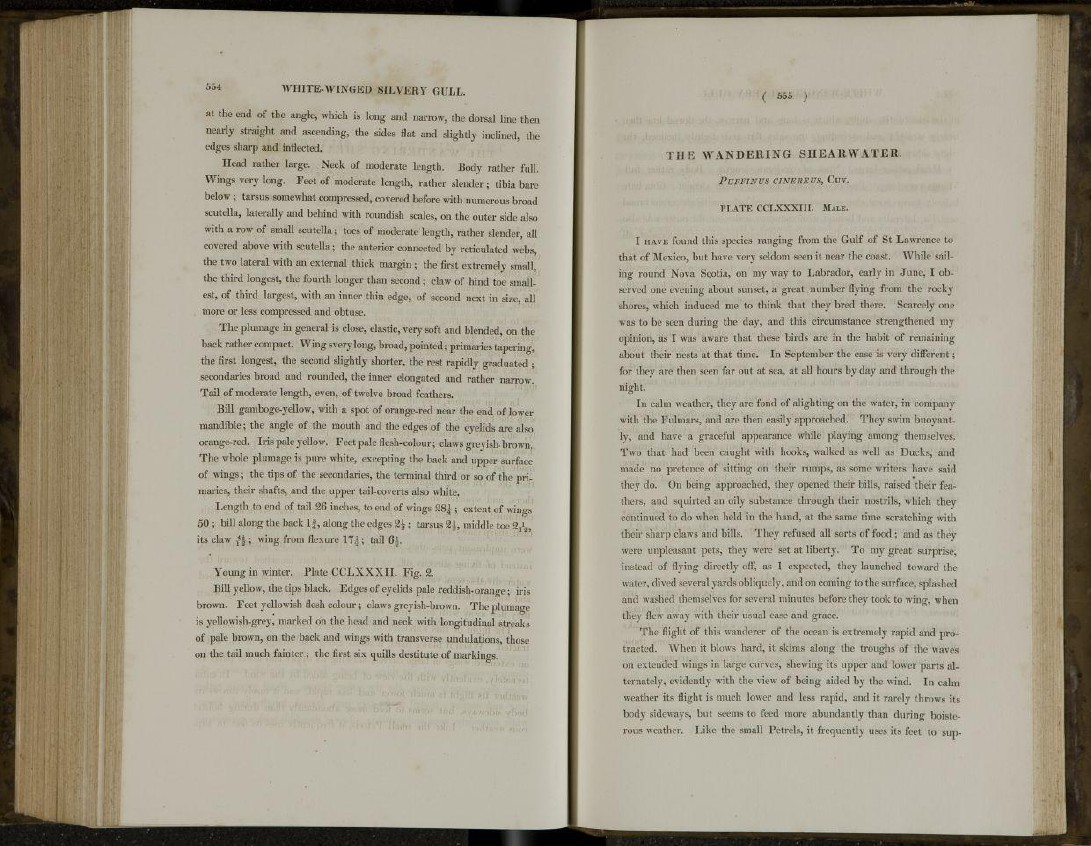
at the end of the angle, which is long and narrow, the dorsal line then
nearly straight and ascending, the sides flat and slightly inclined, the
edges sharp and inflected.
Head rather large. Neck of moderate length. Body rather full.
Wings very long. Feet of moderate length, rather slender ; tibia bare
below ; tarsus somewhat compressed, covered before with numerous broad
scutella, laterally and behind with roundish scales, on the outer side also
with a row of small scutella; toes of moderate length, rather slender, all
covered above with scutella; the anterior connected by reticulated webs,
the two lateral with an external thick margin ; the first extremely small,
the third longest, the fourth longer than second; claw of hind toe smallest,
of third largest, with an inner thin edge, of second next in size, all
more or less compressed and obtuse.
The plumage in general is close, elastic, very soft and blended, on the
back rather compact. Wing svery long, broad, pointed; primaries tapering,
the first longest, the second slightly shorter, the rest rapidly graduated ;
secondaries broad and rounded, the inner elongated and rather narrow.
Tail of moderate length, even, of twelve broad feathers.
Bill gamboge-yellow, with a spot of orange-red near the end of lower
mandible; the angle of the mouth and the edges of the eyelids are also
orange-red. Iris pale yellow. Feet pale flesh-colour; claws greyish-brown.
The whole plumage is pure white, excepting the back and upper surface
of wings; the tips of the secondaries, the terminal third or so of the primaries,
their shafts, and the upper tail-coverts also white.
Length to end of tail 26 inches, to end of wings 284;; extent of wings
50 ; bill along the back If, along the edges 2^; tarsus 2 | , middle toe 2 ^ ,
its claw *|; wing from flexure 17£; tail 6£.
Young in winter. Plate CCLXXXII. Fig. 2.
Bill yellow, the tips black. Edges of eyelids pale reddish-orange; iris
brown. Feet yellowish flesh colour; claws greyish-brown. The plumage
is vellowish-grey, marked on the head and neck with longitudinal streaks
of pale brown, on the back and wings with transverse undulations, those
on the tail much fainter; the first six quills destitute of markings.
THE WANDERING SHEARWATER.
PUFFINUS CINE RE US, Cuv.
P L A T E C C L X X X I I I . MALE.
I HAVE found this species ranging from the Gulf of St Lawrence to
that of Mexico, but have very seldom seen it near the coast. While sailing
round Nova Scotia, on my way to Labrador, early in June, I observed
one evening about sunset, a great number flying from the rocky
shores, which induced me to think that they bred there. Scarcely one
was to be seen during the day, and this circumstance strengthened my
opinion, as I was aware that these birds are in the habit of remaining
about their nests at that time. In September the case is very different;
for they are then seen far out at sea, at all hours by day and through the
night.
In calm weather, they are fond of alighting on the water, in company
with the Fulmars, and are then easily approached. They swim buoyantly,
and have a graceful appearance while playing among themselves.
Two that had been caught with hooks, walked as well as Ducks, and
made no pretence of sitting on their rumps, as some waiters have said
they do. On being approached, they opened their bills, raised their feathers,
and squirted an oily substance through their nostrils, which they
continued to do when held in the hand, at the same time scratching with
their sharp claws and bills. They refused all sorts of food ; and as they
were unpleasant pets, they were set at liberty. To my great surprise,
instead of flying directly off, as I expected, they launched toward the
water, dived several yards obliquely, and on coming to the surface, splashed
and washed themselves for several minutes before they took to wing, when
they flew away with their usual ease and grace.
The flight of this wanderer of the ocean is extremely rapid and protracted.
When it blows hard, it skims along the troughs of the waves
on extended wings in large curves, shewing its upper and lower parts alternately,
evidently with the view of being aided by the wind. In calm
weather its flight is much lower and less rapid, and it rarely throws its
body sideways, but seems to feed more abundantly than during boisterous
weather. Like the small Petrels, it frequently uses its feet to sup